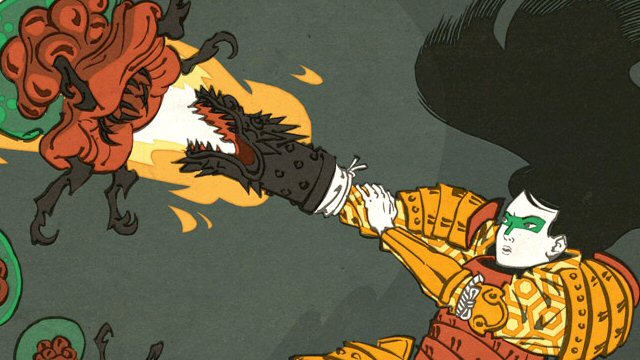
Kitsune
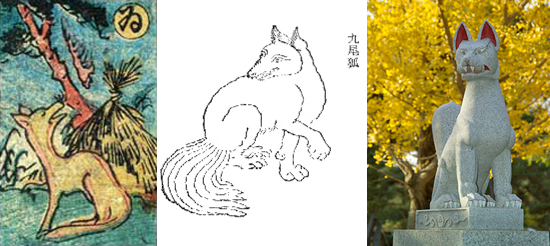
Ah yes, the wily kitsune (or “fox”). In Japan, just like Western culture, the fox is another staple animal in national folklore. Foxes are intelligent, cunning, and often manipulative creatures in any stories, but the Japanese kitsune have some special traits. Kitsune are considered to be servants or associates of the kami Inari— god of agriculture, fertility, industry, and foxes. Sometimes even Inari himself is depicted as taking the form of a great fox.
But kitsune are among some of the most revered spirits in Japanese culture, and for good reason: they are wise and powerful, and it’s said that long-lived kitsune have many tails, and these tails contain great power. Kitsune are also known as tricksters and deceivers, and their tricks range from simple illusions and riddles to outright malevolence. Kitsune can shift their form, and even possess humans. Possessed humans are said to act like a fox, cause trouble, and generally be crazy. In fact, before modern mental health, people were actually diagnosed as being possessed by kitsune and either beaten or burned in an attempt to expel the evil fox spirit! So, where does the kitsune pop up in the Nintendo universe?
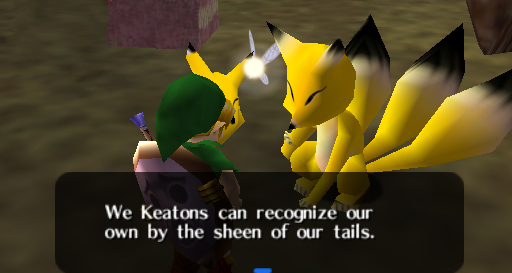
In several games of the Legend of Zelda series, a creature named Keaton appears. While Keatons may look like a Pikachu sans the red cheeks at first glance, they are actually based on kitsune. Keaton was simply a mascot that briefly appeared in the mask quest of Ocarina of Time, but in Majora’s Mask the creature played a much larger role. Donning the Keaton mask in the latter game summoned a flesh-and-blood Keaton. The Keaton has the ability to speak, multiple tails, magic powers, and it even poses trivia and riddles to Link! Those are traits of the classic kitsune if I have ever seen them. Just be glad that the Keaton doesn’t possess Link and make him run naked through the streets. Also, the Keaton mask is tied to Kafei in the longest sidequest of Majora’s Mask. Is it just a coincidence that Kafei, who was transformed into a boy by an evil spirit, has a mask representing a creature that is famous for shapeshifting? Keaton also has an appearance, albeit with a completely different form, in The Minish Cap. In that game, they are common enemies that steal your Rupees when they attack— definitely another nod to the kitsune’s crafty nature.
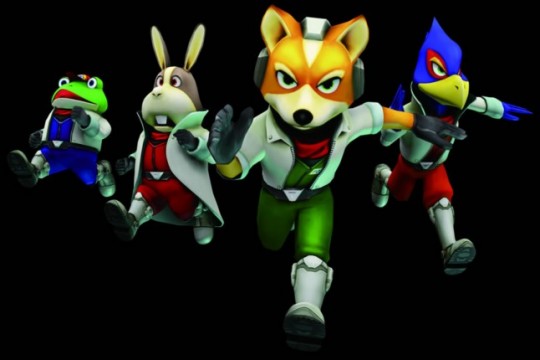
When you think about ancient Japanese legends, the first that comes to mind is probably not space battles, G-Diffuser systems, and barrel rolls. Shigeru Miyamoto took inspiration from a real kitsune shrine when coming up with the characters for the original Star Fox on the Super Nintendo. The arches that the Arwing flies through reminded Miyamoto of similar structures from the Fushimi Inari Taisha, the head shrine in all Japan for Inari, which is covered with kitsune. Miyamoto described the inspiration in an Iwata Asks interview about Star Fox 64 3D:
“Fushimi Inari Taisha is about a 15-minute walk from our former head office12, and there used to be a boys’ baseball team in the area called the Inari Foxes. I thought, ‘Foxes! Now that’s cool!’
While Fox McCloud only really shares his species and not his mannerisms with the mystical kitsune, it just goes to show you how Japanese mythology can define our favorite characters. In the same interview, the developers also outline how the other animals on the Star Fox team were inspired by Japanese folklore as well.
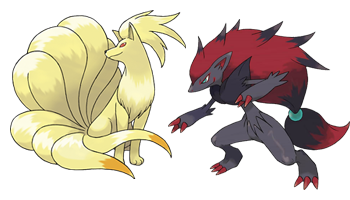
And here we are with the Pokémon again. There’s not one, but two evolutionary lines of Pokémon that are explicitly based on the kitsune. These are the lines of Vulpix and Ninetails, and Zorua and Zoroark. Ninetails is a pretty obvious example, I mean look at those tails! And if you read some of Ninetails’s Pokédex entries as well, they feature telling descriptions like “Grabbing one of its many tails could result in a 1000-year curse,” and “Ninetales casts a sinister light from its bright red eyes to gain total control over its foe’s mind.”
Zoroark is a fairly straightforward reference to the kitsune as well. It looks like a sinister fox, and its ability of Illusion allows it to pretend to be other Pokémon. Also, Zoroark is a Dark-type with moves like Scary Face, Punishment, Foul Play, and Imprison. Once again, these are all tricks from the deceptive and sinister kitsune.
And, of course, like any traditional creature of mythology, you may also see the kitsune’s influence in many other games. Crazy Redd from the Animal Crossing series is a tricky fox who rips off customers with counterfeit paintings. Tails from the Sonic series is a fox with multiple tails and impressive mechanical knowledge, and in Tales of Symphonia, Sheena’s companion spirit Corrine is also a magical fox with multiple tails. The list goes on and on.
(If you’d like to learn more about the kitsune and Inari, here’s some further reading.)
Disclaimer: The awesome banner above was created by the amazing Jed Henry.
As you can see, we owe quite a bit to Japanese mythology in our favorite Nintendo games. But it doesn’t stop there. At this point, literally any story you pick up has influence from traditional folklore. There’s just no way to escape it! What other common threads from ancient tales have you seen represented in your favorite games? Are there any other mystical creatures like those described here? Let us know in the comments below!




 ShareThis
ShareThis







Oh I get it, the masthead artwork is Samus Aran! I didn’t piece it all together until I saw the Metroid and shoulder pads! Gorgeous artwork.
And an excellent article, Kyle! I loved myths of Kitsune as a child, fascinating stuff.
An excellent article indeed.
The worlds Nintendo crafts are so full-embodied and three-dimensional, it is often very easy to overlook that much of that magic is influenced by sources that have proven themselves in terms of longevity.
Being somewhat uninitiated in Japanese culture and folk-lore, it is impressive to see under the magician’s sleeve, so to say. I always thought it absolutely tremendous of all the mythological references Squaresoft used (not Square Enix – more back in the SNES days – even though I’m sure Square Enix does it too) in regards to such titles as Secret of Mana and (especially) Final Fantasy. All the magic-givers were traditional mythology types, with examples such as Undine and Gnome. Then in Final Fantasy, everything from Bahamut to Odin owed it’s allegiance to more European-esque myths and folk-tales.
Having already known the European counterparts, it made those classic RPG experiences that much richer. Using both worlds I had never seen before -and- worlds I was familiar with created a tremendous experience. I imagine it must have been very similar to all the above mentions in this article that Kyle pointed out if one were a Japanese boy or girl, diving into the worlds of Mario, Animal Crossing, or Pokemon for the first time.
Tremendous article Kyle. A real refreshing and eye-opening read. Thank you.